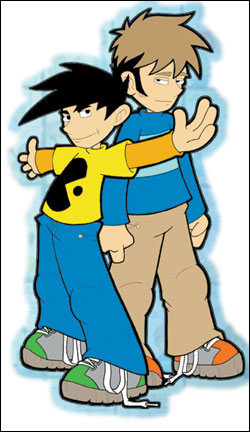You’ve probably never heard of it, but PENNY ARCADE, a thrice-weekly Web comic, is required reading for everyone in the video game industry. The product of two introverted video game addicts and self-described dorksJerry Holkins, who lives in Fremont, and Mike Krahulik, who lives in KirklandPenny Arcade (www.penny-arcade.comdon’t miss the dash) is like The New Yorker for people who play video games, except it’s actually funny and readable, and doesn’t waste your time with 12,000- word gaseous effusions from Hendrik Hertzberg. There is evennaturallya site, successful in it own right, devoted to people who love Penny Arcade, called Penny Arcade Cult (www.pacult.com).
Holkins writes Penny Arcade and Krahulik draws it, an arrangement they have had since meeting in a high-school journalism class. After high school, the pair moved into a cavelike apartment, played video games incessantly, and collaborated on their strip. The comic (which comes out every Monday, Wednesday, and Friday) has, from the beginning, featured a couple of characters named Gabe and Tycho, who also live together and share an obsession with video games. But while Gabe and Tycho still live together and hang out all day playing games and cracking jokes, Holkins and Krahulik now live with their wives, and their marathon gaming sessions are liable to be interrupted by the demands of running a business. For the past three years, the pair has made a full-time living from Penny Arcade, with a combination of reader donations, advertising, and merchandise sales. The site is making more money now than during the dot-com boom and recently took on two more full-time employees just to handle business affairs.
Of course, there are plenty of other sites for compulsive gamers, but they tend to be either whores to their advertisers, or bland clones of each other, chock-full of interchangeable, weirdly earnest reviews. Consensus develops quickly in the video game world, and companies will spend a mint to generate fake buzzflying journalists on junkets to aircraft carriers or English castles, for example. But the Penny Arcade guys talk like real gamers (if real gamers were a lot more intelligent). Their self-aware intellectualism makes playing video games seem like the height of urbanity.
Holkins wrote this about the game Virtua Fighter 4: “When I look at what makes this game upmoves, counters, reversals, stances, and whatnotit’s like I can trace back, through these decisions, into synapses, and see a portion of its creator’s cleverness laid bare. The parameters, the hard laws that establish each experience. The immoral, illicit exceptions to those rules. The intangible quality, inspiration, that creates a system wide enough to contain innumerable creative interpretationsi.e., play.”
The Penny Arcade art has evolved since the early days. Fairly crude at firstalmost like South Parkthe comic is now cleaner and more detailed, with the crisp contours and solid colors of Krahulik’s biggest influence, Stephen Silvers, creator of Disney’s Kim Possible. (Krahulik sketches in pencil, then adds color and effects via Photoshop.) And it’s genuinely funny.
In the first strip, posted Nov. 18, 1998, Tycho says to Gabe, who is seated at a computer, “You haven’t moved an inch since I left! What the hell have you been doing?”
“I’m waiting for this Sin level to load,” Gabe replies (a reference to Sin’s notoriously long delays between levels). “I’ve had time to harness my latent psychic ability.”
“Really?” asks Tycho in the middle panel, now being levitated.
“I also knit you this sweater,” says Gabe, not taking his eyes off the screen as he holds out a sweater exactly like the one Tycho is already wearing.
The navigation is a bit awkward at Penny Arcade, but the best place to start is the tab at the top that says “Latest Comic.” Click the News arrow below the comic for a little essay that Holkins writes to accompany each strip (Krahulik’s posts are here also). Click the back arrow at the bottom of each screen to see the previous installment.
The guys have already turned down a possible deal for a television show based on Gabe and Tycho. “We would write something and send it in, and they would say, ‘Well, it would be funnier if this happened,’ and rewrite it,” recalls Krahulik. After five years of complete freedom, they are not about to give up any creative control. They say they don’t even accept advertising for games they don’t like.
But don’t they want to move to L.A. and be millionaires?
“No!” says Krahulik, “We’re dorks. We don’t even want to leave our houses.”David Stoesz
info@seattleweekly.com




